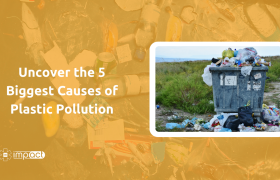Plastic pollution is one of the most pressing environmental issues we face today. Understanding the major causes of plastic pollution can help us take meaningful action to reduce our plastic footprint and protect our planet. Let’s uncover the five biggest causes of plastic pollution and learn what we can do to mitigate them.
The Overuse of Single-Use Plastics
Single-use plastics are one of the most visible contributors to plastic pollution. Items like plastic bags, straws, bottles, and cutlery are designed for convenience, used once, and then discarded. However, these items do not break down easily and can persist in the environment for hundreds of years. They often end up in oceans, landfills, or as litter, where they harm wildlife and pollute natural landscapes. The overuse of single-use plastics reflects a throwaway culture that prioritises convenience over sustainability. Reducing our reliance on these items is essential to combating plastic pollution.
The Hidden Impact of Food Packaging
Food packaging is a significant, yet often overlooked, contributor to plastic pollution. From farm to table, our food is wrapped in layers of plastic packaging—plastic containers, wraps, and takeaway boxes. When food is wasted, the plastic that was used to package and transport it is also discarded, often ending up in landfills or natural environments. This plastic waste persists in the environment, contributing to the growing issue of plastic pollution. By reducing food waste, we can also cut down on the plastic waste associated with it.
Industrial Activities and Plastic Production
Industrial activities significantly contribute to plastic pollution. Industries use plastic for manufacturing, packaging, and transporting materials, generating waste like plastic pellets, packaging, and other byproducts. Improper disposal or spills can lead to serious environmental contamination. Additionally, the production of plastic releases harmful substances into the air and water. Tackling plastic pollution at the industrial level is essential for minimising its environmental impact.
The Menace of Microplastics
Microplastics are tiny plastic particles that have become a pervasive environmental issue. They originate from the breakdown of larger plastic items, the shedding of synthetic fibres from clothing, and the use of microbeads in personal care products. Microplastics are especially dangerous because they are easily ingested by marine life, leading to bioaccumulation in the food chain, which can harm both wildlife and humans. Once microplastics enter the environment, they are nearly impossible to remove, and their small size allows them to spread widely through water systems, contributing to the ongoing plastic pollution crisis.
Mismanaged Plastic Waste
In many parts of the world, waste management systems are inadequate or non-existent, leading to improper disposal of plastics. This includes poor recycling facilities, insufficient waste collection services, and illegal dumping. When plastic waste is not properly managed, it can easily enter rivers, oceans, and other natural environments, causing widespread damage to ecosystems, wildlife, and human health. Improving waste management practices is crucial to preventing plastic from polluting our planet and addressing the root cause of plastic pollution.
Plastic pollution is a complex issue driven by factors like food waste, industrial practices, and single-use plastics. By recognizing these causes, we can take informed actions to reduce our plastic footprint. Through individual efforts, industrial reforms, and improved waste management, we can combat plastic pollution and safeguard our planet for future generations.

